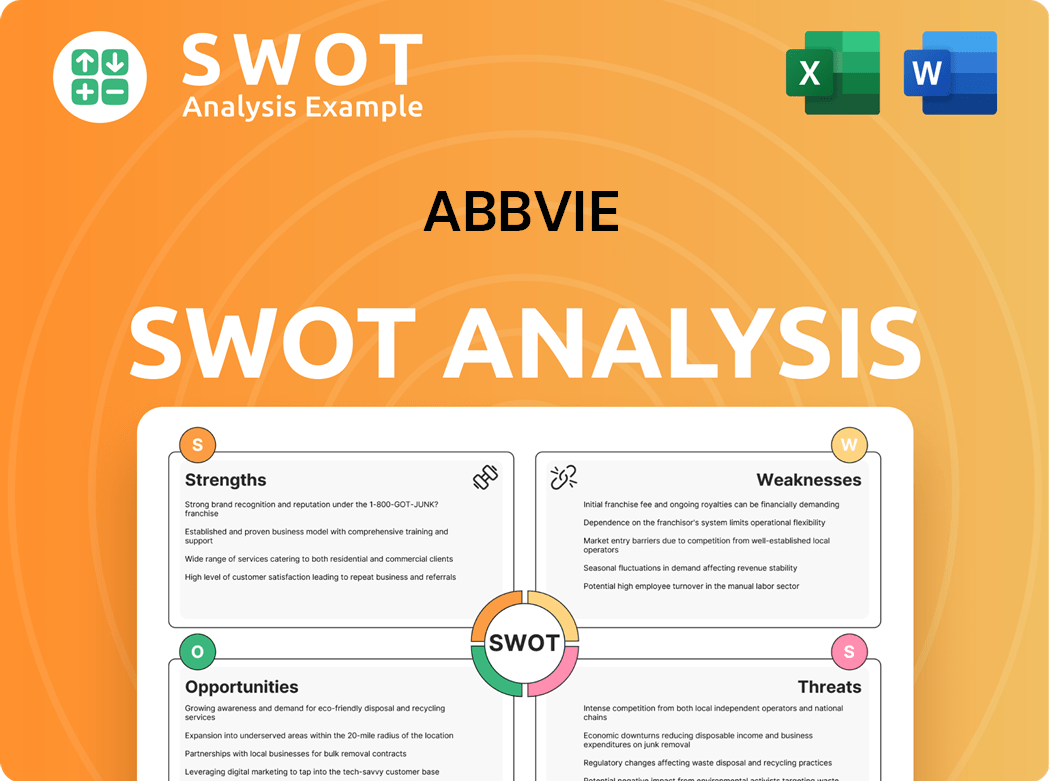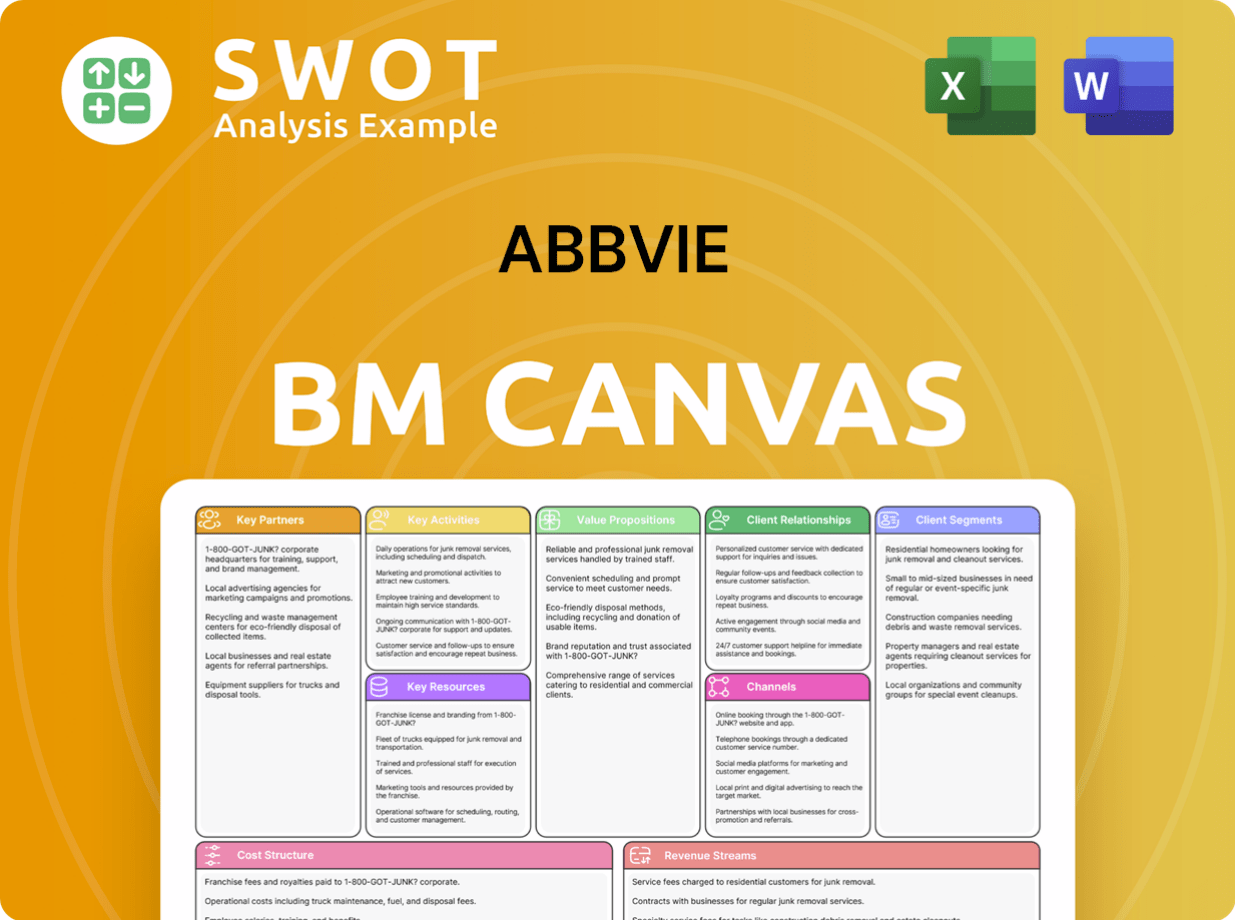AbbVie Bundle
Who Really Owns AbbVie?
Ever wondered who steers the ship at a pharmaceutical giant like AbbVie? Understanding the AbbVie SWOT Analysis is just the beginning. This exploration delves into the ownership structure of AbbVie, a company that has redefined the pharmaceutical landscape since its 2013 spin-off from Abbott Laboratories. Knowing the AbbVie owner is key to grasping its strategic direction.

AbbVie's journey from its AbbVie parent company to a market cap exceeding $338 billion as of June 11, 2025, highlights the importance of understanding its ownership. This deep dive will examine the influence of major shareholders, the distribution among public shareholders, and how these dynamics shape the company's governance and strategic decisions. From its roots to its current status, understanding Who owns AbbVie provides critical insights into its future.
Who Founded AbbVie?
Understanding the ownership of the pharmaceutical giant, AbbVie, requires looking back to its roots. The story begins with Abbott Laboratories, founded in 1888 by Dr. Wallace C. Abbott. However, the current structure of AbbVie as a separate entity stems from a strategic spin-off.
AbbVie's formation wasn't about individual founders in the traditional sense. Instead, it emerged from a corporate restructuring. This means the initial ownership was distributed among the existing shareholders of Abbott Laboratories. This spin-off, announced in October 2011, became effective on January 1, 2013, leading to AbbVie's listing on the New York Stock Exchange (NYSE) on January 2, 2013.
The separation allowed Abbott Laboratories to focus on its non-research businesses, while AbbVie concentrated on its research-based pharmaceutical operations. This strategic move aimed to provide investors with a clearer view of the value of each company. The early AbbVie ownership structure was thus directly linked to the shareholders of its parent company, Abbott Laboratories.
The initial AbbVie ownership was distributed among the shareholders of Abbott Laboratories. This occurred because AbbVie was created through a spin-off, not a startup. The separation allowed for independent valuation of the research-focused pharmaceutical business. You can learn more about the company's background in this Brief History of AbbVie.
- AbbVie is a publicly traded company.
- The company's legal structure is a corporation.
- Major shareholders include institutional investors.
- The company's headquarters are located in North Chicago, Illinois.
AbbVie SWOT Analysis
- Complete SWOT Breakdown
- Fully Customizable
- Editable in Excel & Word
- Professional Formatting
- Investor-Ready Format

How Has AbbVie’s Ownership Changed Over Time?
The evolution of AbbVie's ownership since its spin-off in January 2013 reflects a shift towards institutional investors, typical of a large, publicly traded corporation. Initially part of Abbott Laboratories, the separation established AbbVie as an independent entity, leading to a new ownership structure. This transition was a pivotal moment, shaping the company's future and its relationship with its former parent company.
As of March 31, 2025, institutional investors held approximately 73.56% of AbbVie's total shares outstanding, a figure that remained largely consistent through May 2025, at 73.72%. This concentration of ownership among institutional investors highlights the importance of long-term shareholder value and influences the company's strategic decisions. The company's ability to pay dividends and repurchase shares is dependent on its operational cash generation and access to capital markets.
| Shareholder | Shares Held (as of March 31, 2025) | Percentage of Ownership |
|---|---|---|
| Vanguard Group Inc. | 173,917,865 | 9.852% |
| BlackRock, Inc. | 145,878,142 | 6.222% |
| State Street Corp. | 79,962,967 | 4.53% |
Key institutional shareholders, based on filings as of March 31, 2025, include Vanguard Group Inc., BlackRock, Inc., and State Street Corp. These major stakeholders, alongside others like JPMorgan Chase & Co., Morgan Stanley, and Geode Capital Management, LLC, wield significant influence due to their substantial voting power. The company's market capitalization stood at $338 billion with 1.77 billion shares outstanding as of June 11, 2025, reflecting the scale of AbbVie's operations and the impact of its ownership structure on its strategic direction and financial performance.
AbbVie's ownership is primarily held by institutional investors, indicating a focus on long-term value.
- Institutional investors hold approximately 73.72% of shares as of May 2025.
- Major shareholders include Vanguard, BlackRock, and State Street.
- This structure influences company strategy and financial decisions.
- The company's market capitalization was $338 billion as of June 11, 2025.
AbbVie PESTLE Analysis
- Covers All 6 PESTLE Categories
- No Research Needed – Save Hours of Work
- Built by Experts, Trusted by Consultants
- Instant Download, Ready to Use
- 100% Editable, Fully Customizable

Who Sits on AbbVie’s Board?
The AbbVie board of directors oversees the company's governance, working with leadership to focus on patient needs. As of March 2025, the board nominated four directors to serve until the 2028 Annual Meeting. Recent leadership changes include a Lead Independent Director and new committee chairs. This structure is designed to enhance long-term stockholder value, reflecting a commitment to strong corporate governance.
While specific details about board members representing major shareholders aren't publicly available, the presence of independent directors is a standard practice for balanced governance. The directors and executive officers collectively own less than one percent of AbbVie's outstanding shares. This ownership structure suggests that significant control isn't concentrated in the hands of the executive team or individual board members through direct share ownership. Understanding Competitors Landscape of AbbVie can provide additional context on the company's position in the market.
| Board Role | Details | As of |
|---|---|---|
| Lead Independent Director | Oversees independent board members | March 2025 |
| Committee Chairs | New chairs appointed | March 2025 |
| Director Nominations | Four directors nominated | March 2025 |
AbbVie generally operates on a one-share-one-vote basis, common for publicly traded companies. The company proposed eliminating supermajority voting thresholds in its charter and by-laws, which was put to a stockholder vote in the 2025 Annual Meeting. This initiative aims to increase shareholder influence.
- The binding proposal (Proposal 5) required 80% approval.
- An advisory proposal (Proposal 6) needed 50.1% approval from votes cast.
- These measures reflect a drive towards more democratic shareholder influence.
- The voting structure empowers a larger number of voting shareholders.
AbbVie Business Model Canvas
- Complete 9-Block Business Model Canvas
- Effortlessly Communicate Your Business Strategy
- Investor-Ready BMC Format
- 100% Editable and Customizable
- Clear and Structured Layout

What Recent Changes Have Shaped AbbVie’s Ownership Landscape?
In the past few years, the ownership profile of AbbVie has seen significant shifts, largely driven by strategic acquisitions and capital allocation decisions. The acquisition of Allergan in 2019 for approximately $63 billion marked a major move, diversifying AbbVie's portfolio, particularly with the addition of aesthetics products like Botox. This acquisition did not involve a tax inversion, with AbbVie remaining based in the U.S.
More recently, AbbVie has continued its acquisition strategy to bolster its pipeline, especially to reduce its dependence on Humira, which faced biosimilar competition starting in 2023. Key acquisitions include ImmunoGen for $10.1 billion (finalized in February 2024), Cerevel Therapeutics for $8.7 billion (completed in August 2024), and Aliada Therapeutics for $1.4 billion (October 2024). In January 2025, the company announced partnerships with Neomorph ($1.64 billion) and Simcere Zaiming ($1 billion). In May 2025, a collaboration deal was made with ADARx Pharmaceuticals. These actions show a clear effort to diversify and strengthen its therapeutic areas.
| Metric | Details | Year |
|---|---|---|
| Institutional Ownership | Approximately 73.72% | May 2025 |
| Share Repurchase Authorization Remaining | $3.5 billion | December 31, 2024 |
| Shares Repurchased in 2024 | 7 million shares for $1.3 billion | 2024 |
| Stock Repurchased in Q1 | $606.44 million | Q1 2025 |
Ownership trends at AbbVie show a strong presence of institutional investors, who held approximately 73.72% of shares as of May 2025. While overall institutional holdings have remained relatively stable, there have been quarterly adjustments. For example, Vanguard Group Inc. increased its holdings by 845,787 shares, and Blackrock, Inc. by 3,842,577 shares, as of March 31, 2025. Additionally, AbbVie has been actively engaged in share buyback programs, with a remaining stock repurchase authorization of $3.5 billion as of December 31, 2024. In 2024, the company repurchased 7 million shares for $1.3 billion, and in the first quarter of 2025, it bought back $606.44 million in stock. These buybacks are a strategic move to potentially boost earnings per share and the value of the remaining shares. To further understand the company's approach, you can read about the Marketing Strategy of AbbVie.
Institutional investors hold a significant portion of AbbVie's shares.
The ownership structure is largely dominated by institutional investors, with ongoing share buyback programs.
AbbVie has made significant acquisitions to diversify its portfolio and reduce reliance on Humira.
Robert Michael replaced Richard Gonzalez as CEO on June 1, 2024.
AbbVie Porter's Five Forces Analysis
- Covers All 5 Competitive Forces in Detail
- Structured for Consultants, Students, and Founders
- 100% Editable in Microsoft Word & Excel
- Instant Digital Download – Use Immediately
- Compatible with Mac & PC – Fully Unlocked

Related Blogs
- What are Mission Vision & Core Values of AbbVie Company?
- What is Competitive Landscape of AbbVie Company?
- What is Growth Strategy and Future Prospects of AbbVie Company?
- How Does AbbVie Company Work?
- What is Sales and Marketing Strategy of AbbVie Company?
- What is Brief History of AbbVie Company?
- What is Customer Demographics and Target Market of AbbVie Company?
Disclaimer
All information, articles, and product details provided on this website are for general informational and educational purposes only. We do not claim any ownership over, nor do we intend to infringe upon, any trademarks, copyrights, logos, brand names, or other intellectual property mentioned or depicted on this site. Such intellectual property remains the property of its respective owners, and any references here are made solely for identification or informational purposes, without implying any affiliation, endorsement, or partnership.
We make no representations or warranties, express or implied, regarding the accuracy, completeness, or suitability of any content or products presented. Nothing on this website should be construed as legal, tax, investment, financial, medical, or other professional advice. In addition, no part of this site—including articles or product references—constitutes a solicitation, recommendation, endorsement, advertisement, or offer to buy or sell any securities, franchises, or other financial instruments, particularly in jurisdictions where such activity would be unlawful.
All content is of a general nature and may not address the specific circumstances of any individual or entity. It is not a substitute for professional advice or services. Any actions you take based on the information provided here are strictly at your own risk. You accept full responsibility for any decisions or outcomes arising from your use of this website and agree to release us from any liability in connection with your use of, or reliance upon, the content or products found herein.